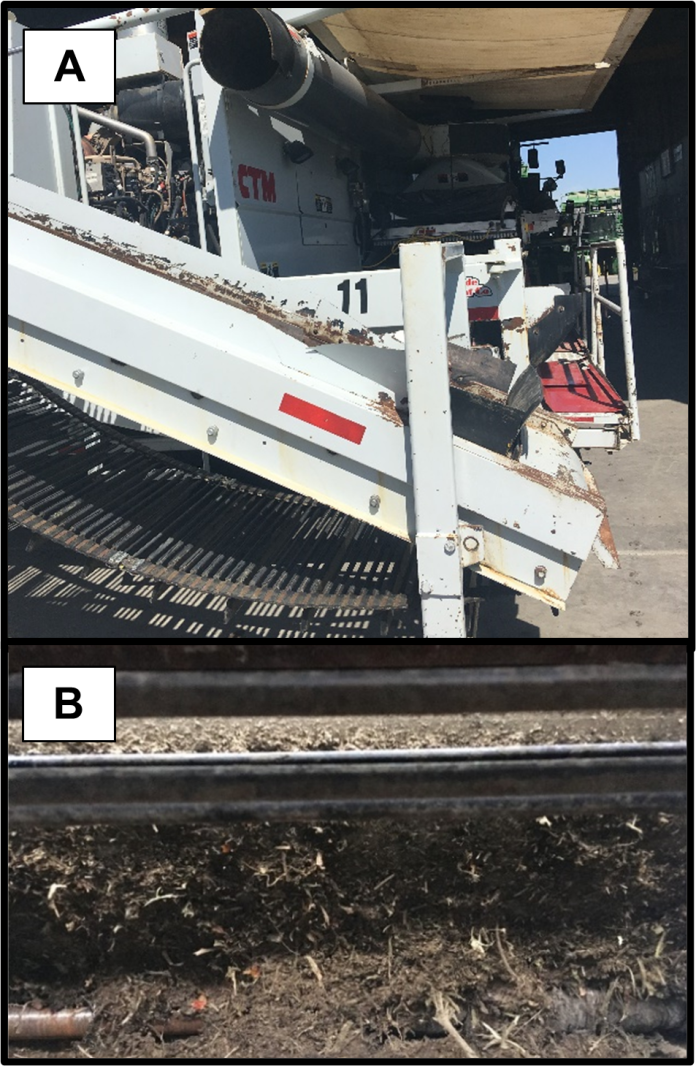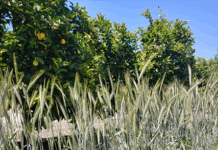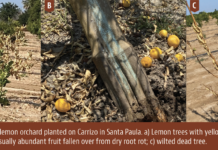
Fusarium oxysporum f. sp. lycopersici (Fol) race 3 causes Fusarium wilt, a disease currently affecting most tomato-producing counties in California. Fol is divided into groups called races based on the ability to overcome plant resistances. Fol race 3 is the most recent race, which broke resistance to race 2. Fol race 3 was long restricted to the Sutter Basin, but began spreading in the early 2000s and is now present in every county with large-scale tomato production, making this one of the greatest economic threats to the industry.
Growers are seeking solutions for this damaging soil-borne disease. In this article, an issue overview as well as the latest information on Fusarium wilt race 3 spread, control and prevention is provided. The focus is on current research that is shining a light on new prospects for management of Fusarium wilt in tomato.
Key Characteristics
Bright yellow foliage on one or several shoots on an otherwise normal plant are the earliest symptoms, starting as early as 45 days after planting but typically occurring at about 60 days. The one-sided yellowing of a branch or whole plant can help distinguish this disease from other wilt pathogens (e.g. Verticillium) and other causes of chlorotic conditions (e.g. nutrient disorders) (Figure 1A). From time of initial symptoms to harvest, disease symptoms progress from shoot yellowing to branch death which leads to partial or entire canopy collapse (Figure 1B). Fruit in this exposed canopy develop sunburn and may rot. Another important diagnostic feature of Fusarium wilt of tomato is the presence of chocolate-brown vascular discoloration in the plant stem (Figure 1C). Vascular discoloration is also a symptom of Verticillium wilt, which can lead to misdiagnosis. At advanced stages of Fusarium wilt, the general canopy collapse is similar to other tomato diseases such as southern blight, bacterial canker and Fusarium crown rots. Because of the potential for misdiagnosis of Fusarium wilt, even by experienced scouters, it is prudent to submit plant samples to a diagnostics laboratory prior to making management decisions.

Survival and Spread
Fusarium wilt race 3 occurs across the Central Valley from the Sacramento Valley region (Colusa, Sutter, Solano, Yolo and Sacramento) to the central San Joaquin Valley (San Joaquin, Stanislaus, Merced, Fresno and Kings) and, most recently, to the southern end of the San Joaquin Valley (Kern) (Figure 2). The pathogen is thought to move locally from field to field by hitching a ride in the soil and plant debris that cling to farm equipment. Hence, the increased movement of farm equipment across processing tomato regions may have facilitated spread of this disease.

Once present in the field, Fol can persist in dead tissue in the soil. Ongoing studies suggest that this pathogen can persist for at least two years in infested tomato tissue after incorporation. In addition, although Fol can only cause disease in tomatoes, it can infect many different non-tomato crops, including melons, pepper and sunflower, without causing any symptoms and survive in non-tomato crop residue in soil. Thus, Fol can feasibly be introduced into a field that has never had tomato, propagate on these silently-infected crops and cause severe losses in the first year the field is planted to tomato. Of note, there are also many Fusarium wilt diseases of rotation crops (e.g. Fusarium wilt of melon, watermelon and lettuce,) but these Fusarium wilts are all caused by completely different pathogens. Therefore, if you have Fusarium wilt of melon in your field, this does not mean you will get Fusarium wilt in your tomatoes.
Management
Overview of IPM for Fusarium wilt
The most effective tool for Fusarium wilt management is preventing pathogen introduction. If introduced into a field, the disease can usually be successfully managed with resistant cultivars (F3 cultivars), although there are some caveats in F3 efficacy. If F3 cultivars are not available for management, pathogen-tolerant cultivars and early-season chemical management options are also available. Crop rotation can help reduce pathogen pressure and reduce risk that an F3 resistance-breaking race will emerge (race 4).
Effective management of Fusarium wilt requires accurate diagnosis. As noted above, there are many diseases that look like Fusarium wilt, and at present there is no way to differentiate these diseases in the field. Before developing a Fusarium wilt management plan, it is critical to submit samples for analysis by a diagnostic lab. Ideally, growers could have their soils tested for Fusarium wilt prior to planting. Although there are no commercial soil testing services available, there are preliminary soil testing tools under development at UC Davis (contact C. Swett for more information.)
Management with genetic resistance
Fol race 3 resistant cultivars, called F3 cultivars, typically develop no disease and are an excellent management tool. The tomato industry has worked hard to overcome challenges in F3 cultivar quality, yield and seed availability. In addition, certain F2 cultivars are “tolerant” of Fusarium wilt race 3 in that their yield does not appear to be significantly impacted in infested fields. Fusarium wilt tolerance is not a listed trait for existing commercial cultivars, but this information is available through seed dealers.
In some cases, F3 cultivars develop Fusarium wilt due to Fol race 3. This is typically attributed to either the presence of off-types (when incidence is below 2%) or environmental stresses (when incidence is higher.) Abiotic and biotic stresses appear to play a role in influencing stability of resistance, and recent studies have demonstrated that salt stress can compromise F3 resistance, leading to Fusarium wilt development in up to 30% of F3 plants in a field. While the role of various stresses in mediating F3 resistance is not well-characterized, research in this area is ongoing. Management of these stresses can help maintain the efficacy of host resistance against Fol race 3.
Chemical control pre- and post-planting
Fusarium wilt race 3 is notoriously difficult to control once established in soil. Although host resistance is the gold standard for management, F3 cultivars are not always available. Chemical management may function as a short-term alternative. Recent studies have shown promising results for pre-plant fumigation with K-Pam HL (AMVAC Corporation) at 30 gal/A or higher (maximum rate of 60 gal/A) for optimal efficacy (Figure 3, see page 6).

Crop rotation
Crop rotation is a common recommendation for management of host-specific pathogens like Fusarium wilt because non-host crops suppress pathogen propagation and survival. However, the efficacy of this method relies on the inability of the pathogen to infect rotation crops. It has been discovered that Fol race 3 can infect many crops without causing symptoms, which may reduce the effectiveness of crop rotation. Several rotation crops were found to be poor hosts and were suppressive to pathogen build up in soils; these include cotton, bean crops (i.e. garbanzo, fava, lima and green bean), grass crops, including wheat and potentially corn and rice (poor hosts, not field tested), and onion (Figure 4, see page 6). These appear to be good crops to grow right after tomato and the year before planting to tomato. Pathogen-enhancing crops should be avoided when possible; these include pepper, melons, pumpkins, and sunflower.

No free rides for pathogens
The most effective tool for Fusarium wilt management is preventing pathogen introduction. On farms where Fusarium wilt is not present, this is best achieved by only using equipment that remains within the farm. However, as this is not an option for most producers, a second option is to use a sanitation regime for shared equipment. There is limited information on which equipment is the most important to target for sanitation, but Fusarium has been found at high levels on harvesters which retain large amounts of plant debris (Figure 5). An assessment of critical control points on harvesters indicates that areas which only have contact with fruit have lower levels of microbes, whereas the chipper and other areas which come into contact with whole plant material have higher levels. Robust analysis of effective sanitation methods is lacking, but preliminary data indicates some efficacy of current practices such as physical removal of contaminants using scrapers, combined with chemical and steam treatment.
Further management options understudy
Compost amendments are commonly used for soil fertility management, and recent studies at UC Davis suggest that composts may also suppress Fusarium wilt in soil. Pathogen-infested tomato residue decomposes more rapidly in soil with long-term inputs of poultry manure compost. Preliminary studies also indicate that cover crops such as hairy vetch may be suppressive to Fusarium wilt, as has been seen for Fusarium wilt of watermelon, but results are inconsistent.
Where to Go Next
There are no documented cases of Fol race 4 in California. However, given the history of this pathogen, it is almost inevitable that a new race (race 4) will emerge that overcomes race 3 resistance. As a result, race 4 monitoring continues to be a top priority across the state.
F3 resistance can be compromised by stress, and Fol race 3 has been documented causing disease in multiple F3 tomato fields every year. Knowing which types of plant stress affect host resistance would help growers prioritize management strategies. Long-term studies of Fol race 3 survival in soil are important for knowing optimal durations for rotating out of tomato.
There are several common rotation crops whose risk status is still unknown, including safflower, alfalfa, potato and hemp. Furthermore, there is clearly a need for soil testing tools for Fol race 3. The UC Davis Vegetable Pathology program is working to develop more rapid molecular tools for both soil detection and diagnosis in plants. Industry innovations in effective sanitation, such as full room steam or fumigation sanitation stations, could provide a breakthrough in slowing spread of Fusarium wilt as well as other soil-borne pathogens.
While the aforementioned management approaches have primarily focused on Fusarium wilt alone, in reality, Fusarium wilt also occurs as part of disease complexes. Developing strategies that minimize damage wrought by these soil-borne complexes is a critical next step in achieving healthy tomato production in California.
For more information, contact Cassandra Swett at clswett@ucdavis.edu.














